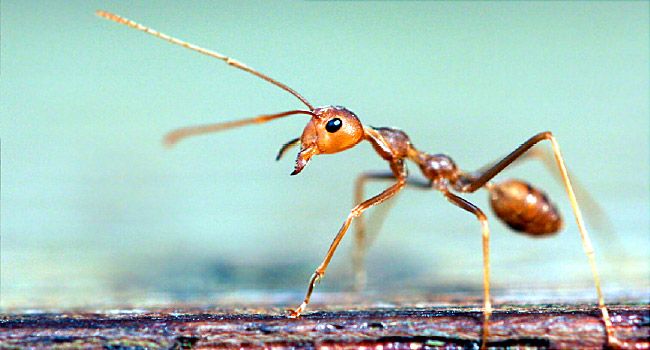Are Ants the Future of Cancer Detection?
Cancer diagnosis is frightening, invasive, time-consuming, and expensive. And more than 1.6 million people get that cancer diagnosis every year in the United States. That’s a lot of biopsies and a lot of looking at cells under highly sensitive microscopes.
. But what if detecting cancer in those samples was as simple as taking a whiff?
We know some animals, like dogs and mice, have very sensitive noses that can sniff out disease. Inspired by those studies, French scientists decided to explore whether much smaller creatures that are known for their olfactory prowess could do the same: ants.
“Using olfaction to detect diseases is not a novel idea,” says Baptiste Piqueret, PhD, a researcher at Sorbonne Paris Nord University and lead author of the study. “Knowing how well ants can learn and how they use olfaction, we tested the abilities of ants to learn and detect diseases.”
While this is still far away from real-life clinical use, it could one day lead to a cheaper, more accessible alternative for detecting cancer. What would this new diagnostic method look like?
Pavlov’s Ant
Cancer cells make volatile organic compounds (VOCs) – organic chemicals that smell and can serve as biomarkers for diagnosis.
To train the ants to target VOCs, the researchers placed breast cancer cells and healthy cells in a petri dish — but the cancer cells included a sugary treat.
“We associated a reward to the smell of cancer,” Piqueret says.
It’s a technique scientists call classical, or Pavlovian, conditioning. A neutral stimulus (cancer smell) is associated with a second stimulus (food) that prompts a behavior. After doing this a few times, the ant learns that the first stimulus predicts the second, and it will seek out the odor hoping to find food.
Once the training was complete, the researchers presented the ant with the learned odor and a new one – this time without a reward. Sure enough, the ants spent more time investigating the learned odor than the new one.
“If you are hungry and you smell the odor of fresh bread, you will enter the closest bakery,” says Piqueret. “This is the same mechanism the ants are using, as you learned that fresh bread odor equals food.”
Dogs can detect VOCs using the same technique but take months and hundreds of trials to condition, the researchers note. F. fusca ants learn fast, requiring only three training trials.
Why Ants?
Why Ants?
Ants communicate primarily through scent, and this sophisticated “language” makes them very sensitive to odors.
“Since ants are already well-attuned to detecting different chemicals, this makes them ideal for scent recognition,” says Corrie Moreau, PhD, an evolutionary biologist and entomologist at Cornell University.
In their tiny ant worlds, the little creatures use chemicals called pheromones to send information to other members of their nest.
“There are alarm pheromones to signal an intruder, trail pheromones so an ant knows which way to walk to a food source, and colony-level odors that signal another ant is a member of the same colony,” Moreau says.
But on closer inspection, you won’t see a nose on an ant. They “smell” with their antennas.
“These specialized structures are covered with highly sensitive receptors to be able to discern even small chemical differences,” says Moreau.
There are over 14,000 species of ants, and as far as scientists like Moreau know, all of them use chemical communication — though some are better than others at detecting compounds, such as those scientists are interested in using to detect disease.
Diagnostic Ants: Realistic or a Curiosity?
Whether or not the new research findings could lead to a real tool for diagnosing cancer is difficult to say, says Moreau. The study only focused on pure cancer cells in a lab and not those growing inside a human body.
Anna Wanda Komorowski, MD, a medical oncologist-hematologist at Northwell Health in New York, found the study interesting and was impressed with how the researchers trained the ants. But more research would be needed to understand how long the ants would remember their training and how long they could be kept in a lab for testing.
But one attractive aspect of the research is that if it worked, it might be a cheaper alternative to normal lab practices for detecting cancer cells. It could possibly also be useful in some low-income settings where labs do not have access to cell stain technologies used to detect cancer cells.
Another glitch with the study, notes Komorowski: “The cells we’d expose them to probably would not be the same cells as those used in the study. They exposed the ants to live cell cultures. Usually, we collect material from biopsy and drop it into formaldehyde, which has such a strong odor. So, the lab protocol for cancer detection would have to be different. It could be kind of tricky.”
And while ants are cheaper than stains and dyes and formaldehyde, you’d have to hire someone to train the ants. In other words, there’d still be a human factor and related costs.
“It would take much more research to figure out cost, and how applicable and reproducible it would be,” Komorowski says.
And then there’s the question of whether the ants would do their cancer-detecting work in the lab only, or if direct patient interaction might lead to a diagnosis more quickly.
“The human body emits many other odors, so the question is whether the ants would be able to ignore all the other scents and focus only on the target scent,” says Moreau.
“But these results are promising,” she notes. “I guess the question is whether a patient would be willing to have trained ants crawl all over their body looking for potential cancer cells.”



